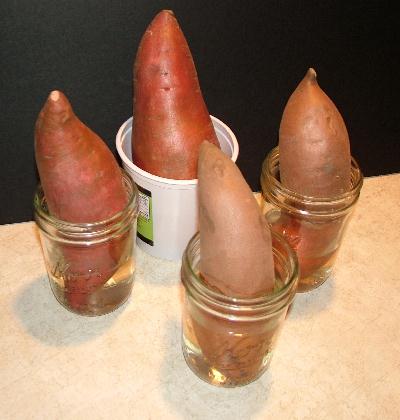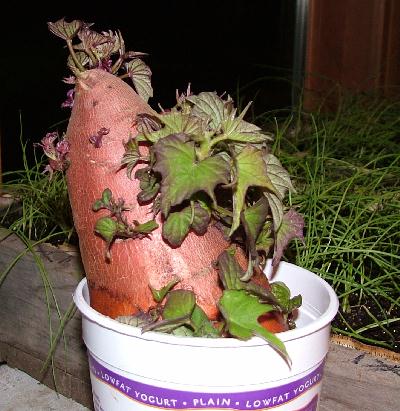Sweet potatoes are considered one of the best foods available. They probably contain a better all-around mix of useful nutrition than any other food that one can grow in the garden. Sweet potatoes are associated with Latin America and the southern US, but they are quite easy to grow in Wisconsin and actually have been an important commercial crop here for many years.
For northern gardeners, the best results seem to be achieved by growing the potatoes under a mulch of black plastic. While I’m quite familiar with and can accept the arguments against the use of plastic film, until I’m shown or I can figure out an alternate method that works as well, the black plastic is the best way I know of assuring myself of a good sweet potato crop in our relatively short growing season.
I’ve had mixed success in starting my own plants. Sweet potato slips can be purchased from commercial growers, but it’s fun (and a lot cheaper) to start your own. I’ve had the best luck by just placing whole potatoes in a jar with a little bit of water as pictured above. Some people prop the potatoes up with toothpicks to keep the bottoms for touching the bottom of the container, and there is logic to this. Sweet potatoes tubers are really quite delicate. You need to make sure the potatoes you use for starts are close to blemish free because bad spots will get soft and rot quickly, destroying your efforts.
I change the water frequently to make sure it’s clean and to curb any fungus or mold growth that would deteriorate the tuber. The starting environment needs to be warm. 80 degrees is recommended, but I don’t have any places in the house that warm and I don’t want to use my heat mat for sweet potatoes so I just keep the starts in the bathroom, which is the warmest room of the house until they start putting out leaves.
There are lots of methods for starting slips and I’d suggest you do a little web searching if you want to start your own and have never done it before. They can be started in soil as well as in water, but I’m happy with the results I usually get with this method, and if it does fail, I have the luxury of buying starts from a commercial grower at a later date.
The top picture shows the starts when they were set in water on January 29th. The lower picture shows the leaf development today, March 27th, on the best start. The big potato started in the white plastic yoghurt cup is way ahead of the rest and is already putting out big leaf sprouts that will eventually become the viney slips. Maybe the white container is better than the glass Mason jars. I’ve switched two of the other three tubers to plastic just to see what happens, but so far, only the big one is putting out a lot of leaf growth, and one other tuber is definitely going to crash. It’s getting mushy at the top.
If I get 18 starts, I’m okay, since 18 is how many I space in my garden bed. If nothing goes wrong with the big one, I’ll get enough from this potato, alone.
The tubers above are two types, Red Garnet and Jewel. Since I did not grow sweet potatoes last year, I purchased these from the local food co-op. I’ve actually had the best luck with starts from my own harvest.
When the sprouts start to put out vine, I transplant them to soil and keep them inside until it is quite warm. That’s usually not before first week of June or even later. I’ll try to show a picture of the transplanting process a few weeks down the road when I’ve got some sprouts that are big enough to work with. The bed preparation and the setting up of the plastic is pretty elaborate too, so that, and the transplanting of the rooted starts should be worthy of a blog entry as well.
difference. I’m now more inclined to think that the potato in the plastic
was just more robust than the others. I’ve typically used wide mouth mason
jars but the potato was too large to fit in the jar so I used a yoghurt
container for that one.
I would not hesitate to use glass or plastic, whatever is available. I
don’t know here you are, but here in Wisconsin, if you don’t have them
started by now, wait ’til next year. It’s too late to get decent starts
from this method.


